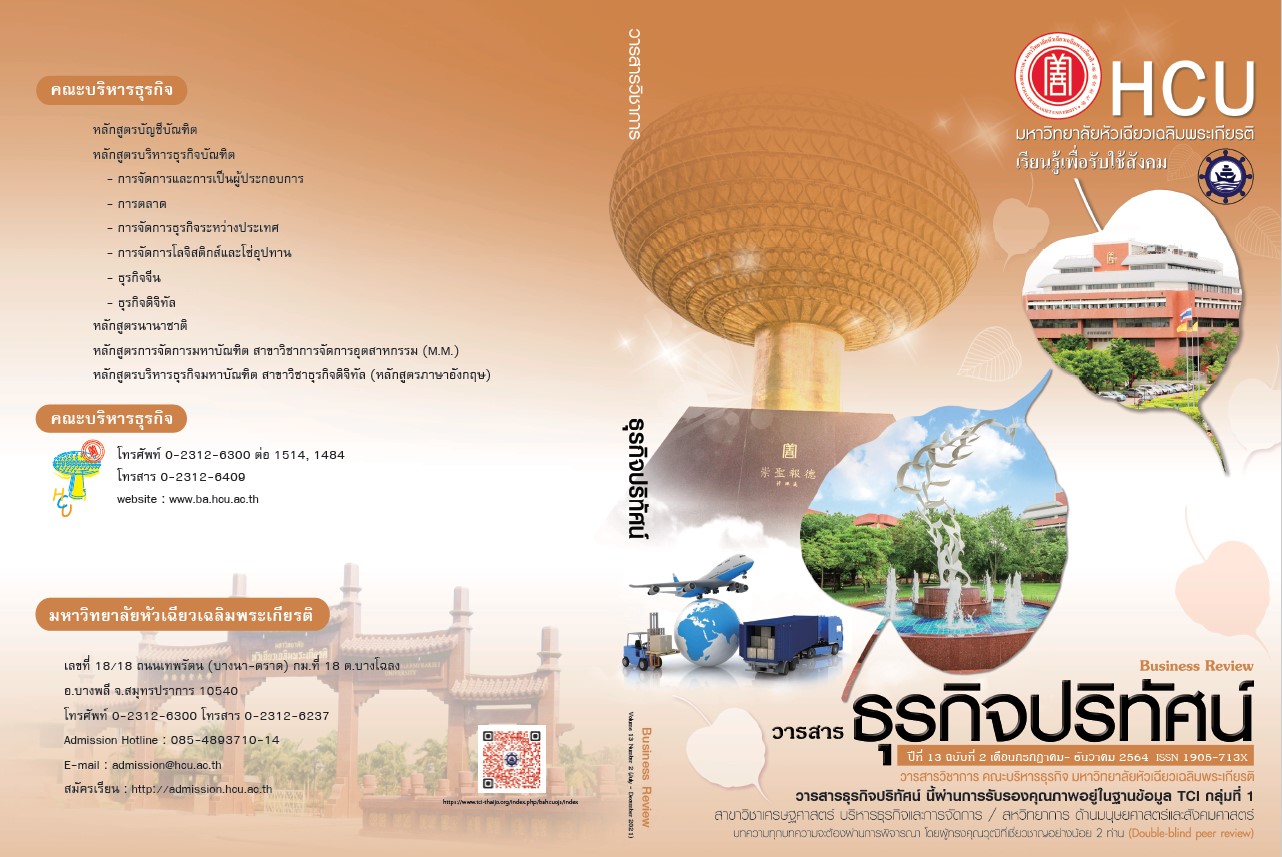การศึกษาความสัมพันธ์ของสภาพแวดล้อมทางกายภาพที่มีผลต่อความเป็นพื้นที่ที่สามของศูนย์การค้าเซ็นทรัลเฟสติวัลหาดใหญ่ จังหวัดสงขลา
关键词:
สภาพแวดล้อมทางกายภาพ, พื้นที่ที่สาม, ศูนย์การค้า摘要
ในสถานการณ์ตลาดปัจจุบันที่ศูนย์การค้าต่างๆมีการเพิ่มประสบการณ์ในการให้บริการแก่ผู้บริโภคในลักษณะของการเป็นพื้นที่ที่สาม ซึ่งเป็นสถานที่ที่ผู้บริโภคเลือกไปนอกเหนือจากบ้านและที่ทำงาน เพราะศูนย์การค้ามีสภาพแวดล้อมและการให้บริการ ทั้งร้านค้า และสิ่งอำนวยความสะดวกที่ตอบสนองการใช้บริการของผู้บริโภคได้อย่างครบครัน ซึ่งการที่ศูนย์การค้าเป็นพื้นที่ที่สามของผู้บริโภคอาจมีผลต่อการใช้บริการศูนย์การค้าได้ การศึกษาครั้งนี้มีวัตถุประสงค์เพื่อ (1) ศึกษาสภาพแวดล้อมทางกายภาพ ได้แก่ ทำเลที่ตั้ง การจัดสภาพแวดล้อม สิ่งอำนวยความสะดวก และร้านค้าเช่า ที่ส่งผลต่อความเป็นพื้นที่ที่สามของศูนย์การค้าเซ็นทรัลเฟสติวัลหาดใหญ่ (2) ศึกษายืนยันความเป็นพื้นที่ที่สามส่งผลต่อความตั้งใจใช้บริการศูนย์การค้าเซ็นทรัลเฟสติวัลหาดใหญ่ โดยกลุ่มตัวอย่างในงานวิจัยครั้งนี้ ได้แก่ ผู้บริโภคที่ใช้บริการศูนย์การค้าเซ็นทรัลเฟสติวัลหาดใหญ่ จำนวน 400 คน ซึ่งงานวิจัยนี้เป็นงานวิจัยเชิงปริมาณ และใช้แบบสอบถามเป็นเครื่องมือในการวิจัย ใช้วิธีการสุ่มตัวอย่างด้วยวิธีตามสะดวก ผู้วิจัยเก็บข้อมูลจากกลุ่มตัวอย่างจำนวน 400 ชุด และสถิติที่ใช้ในการวิเคราะห์ข้อมูล คือ ค่าร้อยละ ค่าเฉลี่ย และการวิเคราะห์สมการถดถอยในการทดสอบสมมติฐาน จากการทดสอบสมมติฐานพบว่า มีเพียงสภาพแวดล้อมทางกายภาพ ด้านทำเลที่ตั้ง( =0.338) และร้านค้าเช่า( =0.456)เท่านั้น ที่มีผลต่อความเป็นพื้นที่ที่สามของศูนย์การค้าเซ็นทรัลเฟสติวัลหาดใหญ่ อย่างมีนัยสำคัญทางสถิติที่ 0.05 ในขณะที่ความเป็นพื้นที่ที่สามก็มีผลต่อความตั้งใจใช้บริการศูนย์การค้าเซ็นทรัลเฟสติวัลหาดใหญ่ อย่างมีนัยสำคัญทางสถิติที่ 0.05 เช่นกัน
参考
กาญจนา วุฒิพงศ์ปรีชา. (2011). แนวทางการจัดสภาพแวดล้อมทางกายภาพพื้นที่ที่สามเพื่อการพบปะทางธุรกิจ. วิทยานิพนธ์ปริญญามหาบัณฑิต, สถาบันเทคโนโลยีพระจอมเกล้าเจ้าคุณทหารลาดกระบัง.
คณะกรรมการนโยบายเขตพัฒนาเศรษฐกิจพิเศษ. (2018). รายงานความก้าวหน้าการพัฒนาเขตพัฒนาเศรษฐกิจพิเศษเมษายน 2561. สืบค้นเมื่อ 10 มีนาคม 2562, เว็บไซต์ http://www.nesdb.go.th/ ewt_ dl_link.php?nid=7551.
ปรียา เทศนอก. (2019). พื้นที่ค้าปลีกเปิดใหม่ปี’61เติบโตจากปีก่อนกว่า 96%. สืบค้นเมื่อ 7 เมษายน 2562, เว็บไซต์ https://www.prop2morrow.com.
ปพนธ์ มังคละธนะกุล. (2016). Starbucks:the third place. สืบค้นเมื่อ 2 สิงหาคม 2561, เว็บไซต์ https://thaipublica.org/2016/10/yangsamkum4/.
ผู้จัดการออนไลน์. (2018). อบจ.สงขลา เปิดเวทีรับฟังความคิดเห็นประชาชน โครงการระบบขนส่งมวลชนโดยระบบราง. สืบค้นเมื่อ 3 พฤษภาคม 2561, เว็บไซต์ https://mgronline.com/south.
ภรัณย์พงศ์ เอกบุศย์. (2010). คุณลักษณะพื้นที่ที่สามของชุมชนมหาวิทยาลัยธรรมศาสตร์(ศูนย์ รังสิต). วิทยานิพนธ์ปริญญามหาบัณฑิต, มหาวิทยาลัยธรรมศาสตร์.
มนตรี อัสนีกร. (2016). วิธีการเลือกทำเลที่ตั้ง-ร้านค้าปลีก-ให้โดน. สืบค้นเมื่อ 10 ตุลาคม 2562, เว็บไซต์ http://www.thaismescenter.com/
วรรณศิริ สิทธินิสัยสุข. (2016). ปัจจัยที่ส่งผลต่อความตั้งใจการเลือกซื้อผลิตภัณฑ์เสริมอาหารของนิสิตระดับปริญญาตรี. งานนิพนธ์บริหารธุรกิจมหาบัณฑิต, วิทยาลัยพาณิชยศาสตร์, มหาวิทยาลัยบูรพา.
ศูนย์วิจัยกสิกรไทย (2019). ค้าปลีกปี 2563: คาดโต 2.8% ..กำลังซื้อผู้บริโภคยังคงกดดันการเติบโตของธุรกิจอย่างต่อเนื่อง. สืบค้นเมื่อ 2 มกราคม 2563, เว็บไซต์https://kasikornresearch.com/th/analysis/k-econ/business/Pages/z3052.aspx.
Band Buffet. (2018). 3 กลยุทธ์ CPN รับมือผู้บริโภคเปลี่ยน สู่ “Center of Life” เมื่อศูนย์การค้าต้องเป็นมากกว่าแค่ที่ช้อปปิ้ง. สืบค้นเมื่อ 1 กุมภาพันธ์ 2562, เว็บไซต์ https://www.brandbuffet.in.th/2018/06/cpn-co-create-to-center-of-life/
Ajzen, I. (1991). The theory of planned behavior. Organizational behavior and human decision processes, 50, 179–211.
Anne, P.C. (2011). Rethinking Oldenburg :Third places and Generation Y in a developing country context. International CHRIE Conference-Refereed, 7, 1-22.
Blower, G. (2013). A critical analysis of the third place concept for acquiring and retaining millennial custom whilst developing brand loyalty in a successful coffee house chain. Undergraduate Dissertation, Winchester Business School.
Camp, H. B. (2015). A study of third place: Benefits of shared leisure practices in Public gathering places. Ph. D. Thesis, Middle Tennessee State University, USA.
Chatzopoulou, E.,and Tsimonis, G. (2010). Shopping Malls: Just Another Shopping Place? The Case of Physical Environment Quality. Academy of Marketing Conference, 1-12.
Chatzopoulou, E., Tsiotsou, R.,and Sirakoulis, K. (2011). Examining the effect of gender on motivational factors for visiting shopping malls. The International Conference on Corporate and Marketing Communications, 16, 362-363.
Gaurav, B., and Achyut, T. (2017). Factors Influencing Customer Satisfaction in Retail Malls in Hyderabad: A Study. Marketing and Consumer Research, 36, 50-57.
Howard, E. (2007). New shopping centres: is leisure the answer?. International Journal of Retail & Distribution Management, 35(8), 661-672.
Leonardo, O.C.,and Marcelo, R.V. (2017). Attraction factors of shopping centers: Effects of design and eco-natural environment on intention to visit. European Journal of Management and Business Economics, 26(2), 199-219.
Levy, M.,and Barton, A. W. (1998). Retailing Management (3rd ed.). Chicago: Irwin McGrawHill.
Odeh, M. R., As’ad.,and H. Abu-Rumman. (2014). The impact of Jordanian shopping malls’ physical surrounding on consumer buying behavior: Field study. International Journal of marketing studies, 6(3), 135-141.
Oldenburg, R. (1989). The great good place. New York: Marlowe.
Oldenburg, R.,& Brissett, D. (1982). The third place. Qualitative Sociology, 5(4), 265-284.
Purnell, D. (2015). Expanding Oldenburg: home as third place. .Journal of Place Management and Development, 8(1), 51-62.
Putnam, R. D. (2000). Bowling alone: The collapse and revival of American community.New York:Simon& Schuster.
Rosenbaum, S. M. (2003). The role of third places in older customers’lives. A Dissertation Degree Doctor of Philosophy, Arizona State University.
Sadachar, A. (2014). Indian consumers' patronage intention toward shopping malls: Application of an experience economy perspective, Graduate Theses and Dissertations, Iowa State University.
Shaare, A., and Nur, S. M. (2018). Young adults’ satifaction towards Hipster Cafes: The Brewing factors. Advances in Business Research International Journal, 41-52.
Tumanan, R.,Mary, A.,& Joseph, R. G. L. (2012). More than just a cuppa coffee: A multi-dimensional approach towards analyzing the factors that define place attachment.
International Journal of Hospitality Management, 31, 529– 534.
Ute, W.,& Bo, E. (2012). The physical environment as a driver of customers' service experiences at restaurants. International Journal of Quality and Service Sciences. 4(2), 104-119.
Vashisht, A., Wadhwa, B.,and Shauppal, A. (2014). Study of attitude of Delhi shoppers towards mall shopping experience. Journal of Research in Commerce & Management, 3(10), 42-50.
Yeh, S.,& Huan, T. (2017). Assessing the impact of work environment factors on employee creative performance of fine-dining restaurants. Journal of Tourism Management, 58, 119-131.
##submission.downloads##
已出版
##submission.howToCite##
期
栏目
##submission.license##
บทความที่ได้รับการตีพิมพ์เป็นลิขสิทธิ์ของวารสารธุรกิจปริทัศน์
ข้อความที่ปรากฏในบทความแต่ละเรื่องในวารสารวิชาการเล่มนี้เป็นความคิดเห็นส่วนตัวของผู้เขียนแต่ละท่านไม่เกี่ยวข้องกับมหาวิทยาลัยหัวเฉียวเฉลิมพระเกียรติ และคณาจารย์ท่านอื่น ๆ ในมหาวิทยาลัยฯ แต่อย่างใด ความรับผิดชอบองค์ประกอบทั้งหมดของบทความแต่ละเรื่องเป็นของผู้เขียนแต่ละท่าน หากมีความผิดพลาดใดๆ ผู้เขียนแต่ละท่านจะรับผิดชอบบทความของตนเองแต่ผู้เดียว




